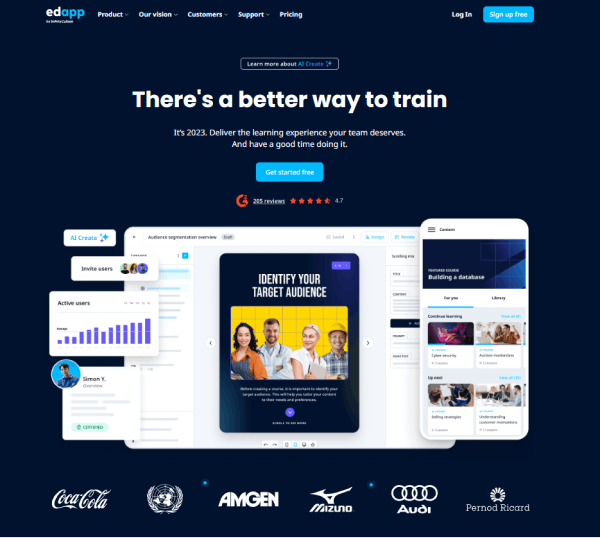10 Onboarding best practices

Starting a new job can be both exciting and overwhelming for your new employees. That’s why it’s crucial you have an effective onboarding process in place to make sure they feel welcomed and supported the moment they join your organization. Investing a memorable onboarding experience not only helps them integrate into the company culture but also enhances their productivity and job satisfaction from day one.
In this article, we’ll explore the best practices for onboarding new employees and make sure that their transition to your company is as smooth and successful as can be.
1. Start with a good pre-boarding
Pre-boarding is the practice of engaging new hires before their official start date. It sets the tone for a smooth onboarding experience and helps new employees feel valued and welcomed right from the start.

According to a study conducted by analyst Zach Lahey from Aberdeen Research, immersing new hires in the company culture before their official start date actually gets them engaged and excited. By including pre-boarding in your onboarding process, you're laying the ground for a quicker transition and a motivated team.
Start your pre-boarding by sending your new hires a detailed welcome email or letter that includes information about their start date and time and any necessary paperwork. You can also discuss compliance-based workplace matters, like whether they’ll be paid via Bacs payment, check, or direct deposit. To ease their first-day jitters, give them specific directions on where to go and who to see when they arrive at the office.
It’s also a good idea to give your new hires a personalized welcome package with branded merchandise, like a mug, sweatshirt, or booklet with your logo. It's an effective way to get them pumped about joining your company.
2. Prepare a structured onboarding plan
Having a structured onboarding plan is also one of the best practices for onboarding. It serves as a roadmap for your new hires to follow, helping them better understand their roles and responsibilities. It also reduces the uncertainty and confusion that often come with starting a new role and allows them to hit the ground running.

When creating an onboarding plan for your new hires, make sure to outline the key activities, sessions, and meetings they need to attend during their first weeks. It’s also a good idea to include a timeline that maps out the onboarding process. This will give your new hires a better outlook on the things to anticipate as they join your team.
3. Introduce them to company culture and values
Introducing new employees to your company's culture and values is key to fostering a sense of belonging and alignment. It allows them to dive deeper into what’s important to the company, how decisions are made, and what kind of environment they're stepping into.

You can start by conducting orientation sessions to educate your new hires about your mission, vision, and core values. Share stories and examples so they know how to put those values into action. It’s also a good idea to open up your upcoming company events and team-building activities and encourage their participation to facilitate networking and collaboration.
For remote employee onboarding programs, you can send your new team a copy of your company manuals or books. You can also turn them into elearning courses they can access anytime and anywhere. To speed up this process, award-winning training tool EdApp can definitely lend a hand.

This learning management system (LMS) has a powerful creator tool. It's designed to help you put together expertly-designed onboarding training materials, without any prior technical expertise.
Simply break down your company culture and values into easy-to-digest pieces of information and transform them into beautiful and engaging courses. EdApp offers user-friendly concept templates that allow you to present the information in a simple and concise manner. And if you want to add some fun and interactivity, EdApp also has templates for creating games, quizzes, and assessments to test your employees' knowledge.

From creator tool to quiz maker, EdApp has all the tools you need for your employees' onboarding program!
4. Foster peer connections
When new hires feel comfortable, engaged, and motivated in their new environment, they're more likely to thrive. And fostering peer connections plays a key role in making that happen. When new hires have strong bonds with their peers, it becomes easier for them to seek assistance, ask for help, and collaborate. They feel more at ease reaching out, knowing they have a supportive network to rely on.

To facilitate these connections, there are various activities you can consider. Start by giving them a tour of the office and introducing them to different teams. During company stand-ups, encourage introductions and have them share their career experiences and hobbies. This creates opportunities for them to find common ground with their new colleagues and build connections based on their shared interests.
Team building activities and social events can also help foster peer connections. Host games and activities that’ll give everyone the chance to connect, interact, and build relationships. These fun-filled experiences help bridge the gap and create a welcoming environment where new and existing employees can easily interact and form meaningful connections.
5. Assign a buddy or mentor
Assigning a buddy or mentor to new employees is also valuable onboarding practice. An interesting study even shows that 87% of organizations that use this strategy during onboarding see an increase in new employees’ proficiency.

When selecting a buddy or mentor, it's crucial to choose an experienced employee who can confidently guide your new hires, answer their questions, and offer support during the initial days and weeks.
It’s also equally important to find someone who is friendly and approachable. If possible, consider assigning a colleague rather than a direct manager, as this can help new hires feel more at ease when seeking guidance about company culture and processes.
6. Familiarize them with the necessary tools and resources
One of the top employee onboarding practices is getting your new hires familiarized with the tools and resources they'll need for their job. Introduce them to the relevant software, equipment, and information systems during the onboarding process to help them navigate their tasks with ease. This hands-on approach not only boosts their confidence and readiness to tackle their responsibilities but also keeps those early days free from unnecessary frustrations or confusion.

You can educate your employees about these tools and resources through training and workshops. It’s also worth considering creating a central repository of frequently asked questions (FAQs), manuals, and best practices that new employees can always refer back to.
If you're searching for a platform that allows you to create training materials and at the same time, conveniently store your manuals, EdApp is the perfect solution.
Thanks to this onboarding LMS, you can easily design engaging courses that guide new hires on how to use your tools and resources effectively. And with its Briefcase feature, you can keep additional resources like PDFs, images, and videos. This makes it easy for your team to access and reference them anytime, anywhere.

7. Communicate expectations clearly
Communicating your expectations during the onboarding process allows your new employees to understand what is expected of them. It gives them an idea of how they can align their efforts and prioritize their tasks in a way that’ll contribute to the organization’s success.

During their first week, make sure to set a time to guide your new hires through their job description and discuss key performance indicators (KPIs). It’s also important to set achievable and measurable goals, so they have a roadmap to follow and milestones to strive for.
This onboarding practice should be tied to regular feedback sessions. This feedback loop not only helps them stay on track with their goals but also offers an opportunity to identify areas where they’re currently failing and give support and assistance as needed.
8. Schedule regular check-ins with your new hires
In a LinkedIn study, 72% of employees listed one-on-one time with their direct manager as the most important part of any onboarding process. It just goes to show how crucial it is to schedule regular check-ins to interact and connect with your new hires.

To do it, you can set up weekly or bi-weekly meetings where you can sit down with your new hires to discuss their tasks, track their progress, and address any questions or concerns they may have. You can also use this chance to get their feedback on your onboarding process and ask them for any additional guidance they might need.
If your new hires are working remotely, take advantage of technology to facilitate regular check-ins. Use video conferencing tools like Zoom or Microsoft Teams to conduct virtual meetings. These platforms offer the advantage of face-to-face interactions, allowing you to maintain a personal connection with your new employees even when you're physically apart.
9. Avoid overwhelming your new hires
It’s important to remember that your new hires are probably still getting familiar with your company's processes and policies. And consistently overwhelming them with new information can lead to confusion and stress. This could hinder their ability to process everything and slow down their productivity.

To create a positive onboarding experience, try to structure your onboarding program in a manageable and digestible manner. Instead of overwhelming new hires with a flood of activities all at once, spread them out throughout the week and limit the number of activities per day.
This onboarding practice will make it easier for them to actively participate in the onboarding process. It also gives them enough time to absorb everything they need to know about their role and the company.
10. Evaluate and improve the onboarding process
Learners' needs and preferences are always changing, and what worked in the past may not be as effective today. To keep your onboarding process relevant and engaging, you need to prioritize evaluating and improving your onboarding process.

During the onboarding period of your new employees, take the opportunity to gather their feedback and insights. Regularly check in with them to understand their likes and dislikes about the onboarding experience. This feedback will help you pinpoint areas that can be further refined and enhanced. And involving them in the process by asking for their suggestions fosters a sense of ownership and collaboration in their onboarding journey.
Transform your onboarding process with the ultimate onboarding tool today! Experience the power of EdApp by signing up for free.
Author
Jen Avelino
Jen is a learning expert at EdApp, a mobile-based training platform that helps corporates and businesses bring their training solutions to the next level. She carries an extensive writing experience in a variety of fields, including architecture, the gig economy, and computer software. Outside of work, she enjoys her free time watching her favorite series and documentaries, reading motivational books, and cross-stitching.
